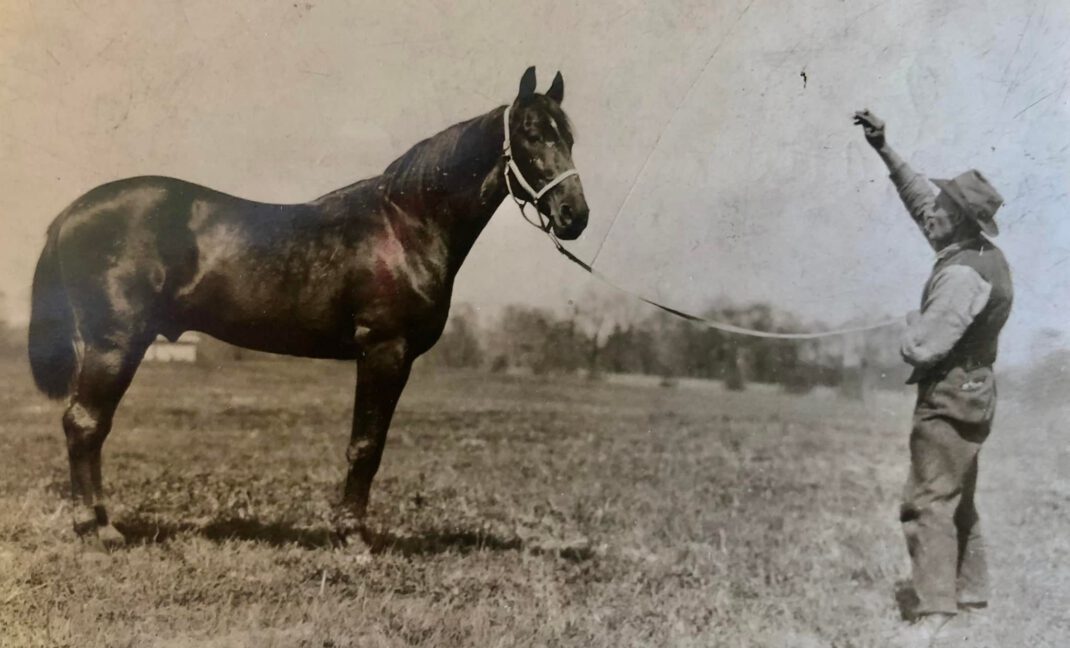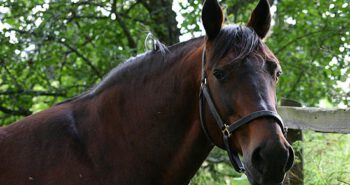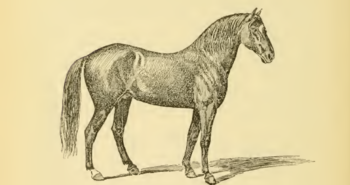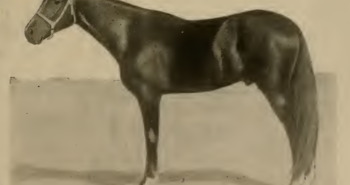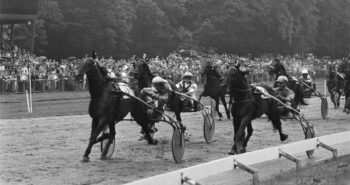He turned out to be one of the most important stallions in standardbred history, but it could have been very different. The colt was a challenge for his trainer and only made two starts in his first two seasons. In the end he only lasted five more races before a disappointed owner sold him to a buyer whose partner really didn’t want the horse at all. But Peter the Great persevered and became a true legend and foundation stallion of the standardbreds.
The story of Peter the Great revolves around Kalamazoo, Michigan. At Samuel A. Browne’s famous stud farm the mare Santos saw the light in 1887. By then, her sire Grand Sentinel was already dead. He had been turned out in the paddock in January the same year, and hit an icy spot when playing around in his paddock. The stallion was so badly injured he needed to be put down. At yearling auction, Santos was sold $850. The new owner, JI Case of Janesville, Wisconsin, clearly didn’t see that much in the mare and put her up for sale in February the following year. The two-year-old filly was then purchased by breeder HD McKinney, a cousin of Case, for $470. When Santos failed to get in foal she was traded back to her breeder Samuel A. Browne. She was placed in the hands of trainer Peter V Johnson, who used her as a driving horse in the winter and spring of 1890-1891. In foal to Ambassador, Santos was sold $750 at auction in December 1891 to fellow Kalamazoan Daniel D Streeter, and she gave birth to a filly, named Episode, the following year.
The next foal was from Michigan’s speed sire par excellence, Pilot Medium. When it was time to break in the colt, Streeter sent him to trainer Peter V Johnston. The latter had retired from training and racing horses and moved to Michigan, but not after gaining a reputation as one of the most skilled in the business and a “maker of colts.” When Johnston returned the youngster after breaking him in, he told Streeter “You have a good colt.” The next spring Streeter asked Johnston to train a few of his horses. Johnston declined, saying he was out of the business and intended to keep it that way. “Well, you said I had a good colt, and I want you to train him,” Streeter responded. Johnston didn’t want to disappoint the wealthy Streeter and replied that “if you will send the colt to my town stable, send a man to take care of him, send the feed, and pay the expenses, I will take him; but there will be no charge for the training. I am not going to make a business of training horses, nor am I going to stay in Kalamazoo all summer,” presumably thinking that might discourage Streeter. It didn’t. “You’ve got a colt to train” was the simple response. The following day the two-year-old colt arrived at Johnston’s stable as well as another horse, the explanation being that the caretaker who had been sent along could care for both and the extra horse was for Johnston’s private driving.
Made speed fast
The colt, of course, would come to be known as Peter the Great, however he was not given that name until close to the Junior Kentucky Futurity – when he needed a name to start. The legendary horse was then named for his trainer. Johnston himself wrote a lengthy article, published in January 1910, on how he trained and developed the great colt. “I began, after Peter came to my town barn, by driving him on the streets every morning that spring, and where the footing was good I would let him step a little. About the 25th of May I said to Mr Streeter: ‘This colt can step a 2:50 (1.45,6) shot.’ ‘If he can trot an eight in :20 on June 1 he will do to keep in the Futurity’ said Mr Streeter, so on that day I went to the track for the first time. It was three miles from town, so the colt had all the jogging he needed. I went once around the track slowly, the next time a little faster, and brushed the last eight in :22. Then around again, and that time he stepped the homestretch eight in :19, so the Futurity payment was made.
Then I began regular training, working Peter three times a week, Tuesday, Thursday and Saturday, as Mr Streeter could only be there Saturday. I would jog the colt three miles and wrong way of the track, then turn and go once around slowly. Then next time a little faster, the last eight at a pretty fast clip. Then jog around once more, with the last eight as fast as he could do it. Under this plan Peter made speed so fast he soon could step an eight in :16, a 2:08 (1.19,5) gait. About July 1 the plan was changed, working Wednesday and Saturday. We would go two heats each day with a fast brush at the end of the second mile. On Saturdays I would let him step one good quarter, :33 1/2 or :34. That was all the speed I could make on the farm track, so as I was going fishing for two weeks the first of August I had Peter turned out nights and not driven, believing the play spell would be beneficial.”
A few sources, published a few years later, claimed that Peter the Great suffered from distemper and could not be trained for the Kentucky Futurity until the middle of September. However, Johnston’s account does not include any mention of this.
“On my return I trained at Grand Rapids, starting with three heats twice a week, all slow, then changed to three heats one workout, and four the next, with fast brushes at the end of two of the Saturday miles. Peter then could trot an eight in :15, but I never worked him a mile so fast but that he could trot the final eight faster than any other. The first, good mile I asked of him he went in 2:20 (1.27,0), the last half in 1:08, the last quarter in :33. That was in 1897, and looked good for a 2-year-old.”
Wanted to pace
One challenge with Peter the Great, however, and all foals by Santos, was their proclivity for both gaits. Consequently, Peter and his siblings needed quite a bit of weight in front to trot well.
“A few days before we shipped to the Lexington to trot the Futurity, Mr Streeter came to see the colt work. I had Peter show behind that day and the blacksmith made a change in the shoes by turning a little heel on them. The first mile was in 2:38 (1.38,2), and Peter tried to break, whereas he formerly had been steady. The next mile was 2:32 (1.34,5), but he made a break and pulled and choked. I always had driven him with a side check, but now put on an overdraw. Then he wouldn’t trot at all. I scored him ten times, and whenever he got up to a 3:00 (1.51,9) clip he would break and run. I went back to the barn, put three ounces more weight on in front, took the check bit out of his mouth and checked him under the chin. Then he trotted a mile in 2:19 1/2 (1.26,7), but did not go right.
That was Friday. Monday I tried him again, but he was not good. Then I changed his shoes, going back to the original pattern. The next day Mr Streeter came to see him work again. The miles were 2:40, 2:30 and 2:19 (1.39,4, 1.33,2 and 1.26,4). Then I put the three ounces weights back and worked him in 2:30 (1.33,2) but he was not balanced and after that I had to use the six ounce weights.”
A race against time to get him ready
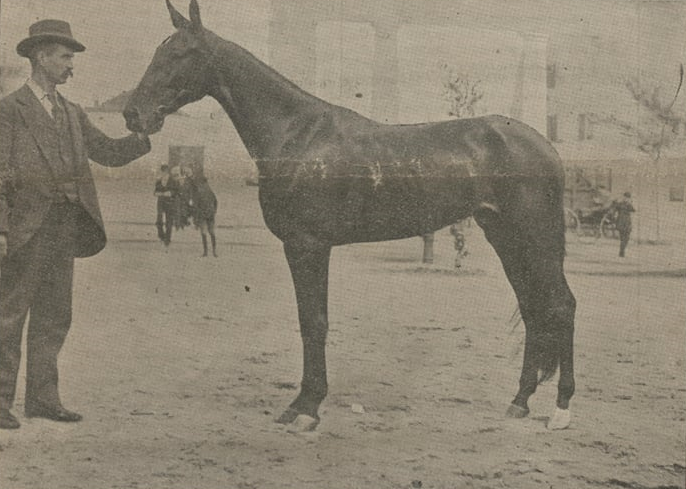
Days before the Junior Kentucky Futurity, Johnston got an even more serious problem to deal with, but managed to get the son of Pilot Medium fresh – barely – and he finished second in both heats. In the Junior Kentucky Futurity, Janie T took the lead in both heats. She was pressed by Peter the Great, and in the first heat he kept up the pressure to the finish line, in the end losing by half-a-length. In the second heat Peter tired in the end and Janie T pulled away and won by two lengths in 2:15 1/4 (1.24,0), the other starters being Limerick, third, Charley Herr, fourth and Miss Duke, Ambi and Lady Geraldine, all distanced.
“At Lexington, working Peter three days before his race, a quarter boot broke and chafed him so that the next morning I could hardly get him to move. The morning of the race I sprayed his ankle with ether for two hours. Peter went a good race, forcing Janie T to trot in 2:15 to beat him, but extra weight tired him. That was Peter’s only race as a 2-year-old, and the following winter he was at my barn, running out in a paddock pleasant days and being fed oats, corn, hay, bran, and carrots, but not driven. As a 3-year-old, Peter’s only engagement was the Kentucky Futurity, $10 000 to the winner, and all he needed was conditioning , as his 2-year-old race showed him to have speed and manners.”
Getting revenge
Johnston trained him at home in Kalamazoo, but in June he took the colt to Joliet, Illinois until August 1. There Peter was given slow miles without the typical fast brushes in the end. Just before leaving Joliet and moving the horse to Grand Rapids Johnston worked Peter the Great an easy mile in 2:16 (1.24,5), the last quarter below 32 seconds. At Grand Rapids the three-year-old was given a lot of miles between 2:18 and 2:25 (1.25,8 and 1.30,1). As it turned out, the horse was more than ready for the Kentucky Futurity on Oct 6, 1898 – and ready to get his revenge on Janie T.
According to the Lexington Herald; “After two days’ postponement on account of the rainy weather and a muddy track, the beginning of the end of the greatest season of harness racing was inaugurated at the grounds of the Kentucky Trotting Horse Breeder’ Association on Thursday. It was the twenty-sixth annual meeting, and it opened to a large and enthusiastic crowd, numbering about 6000 souls. The card was a good one, bur rather too lengthy, but this could not be bettered, as things will have to be crowded to get the program completed by the end of the coming week. The track was still heavy when the bell tapped for the first race at 10:30 o’clock, but as the afternoon advanced its condition was greatly improved. Fast time was not expected, nor was it made, but the heats in some of the races were closely contested and afforded excellent sport. (…)
The third race was the Kentucky Futurity and has six starters – Charley Herr, Limerick, Janie T., Lexie May, Seraphina and Peter the Great, Dartmore having been scratched due to sickness. Janie T had the pole, with Peter the Great second, Limerick third, Charley Herr fourth, Lexie May fifth and Seraphina sixth. In the pool Herr sold for $25 to $30 for the field. They were given the word on the third score, and Charley Herr took the lead, and at the turn led Peter the Great by a length, who was in front of Seraphina. This position was virtually the same at the quarter, but a few hundred feet from the quarter Peter the Great challenged Herr and at the half was leading by a length, and Seraphina was coming easy in third place, two lengths away. This was the order to near the three-quarter pole, where Herr broke and Peter the Great and Seraphina drew away from him. It was an easy thing for Peter the Great through the stretch and he beat Seraphina by four lengths, with Charley Herr third, six lengths back. Limerick was fourth, Janie T fifth and Lexie May distanced. The time was 2:15 3/4 (1.24,4).
In the books for the second heat Charley Herr was 2 to 1, while Peter the Great was advanced as favorite at 2 to 5. In the pools Peter the Great was $100 to $40 against the field. They got away on the second score with Herr and Peter the Great neck and neck about six lengths in front of Limerick at the quarter. At the half Peter the Great led Herr by a length in 1:06 1/2. They were all strung out going from the five-eights to the three-quarters, but as they headed into the stretch Limerick had come up and was nearly on even terms with Herr coming through the stretch, the latter whipping, beating the Prodigal gelding by half a length. Peter the Great winning by three lengths and going easy in 2:14 1/2 (1.23,6). Seraphina was fourth and Janie T last.
In the third and deciding heat Peter the Great got away in the lead, and was followed by Charley Herr, who maintained second position until well into the stretch, where he was collared and passed near the distance by Limerick, who had been third all the way, the latter finishing four or five lengths behind Peter in 2:12 1/2 (1.22,3), the fastest heat even trotted in the futurity. Peter the Great got first money, while second, third and fourth was divided between Limerick, Charley Herr and Seraphina.”
Peter V Johnston’s contract with owner Streeter was very simple: Johnston was to receive half of Peter the Great’s net earnings in the Kentucky Futurity. That amounted to $3,250. Johnston never drove again in a race. As for Janie T, the daughter of Bow Bells was not sound but started anyway, she was sold off for $2,000 by her owner and trainer George Fuller a little later. After only one foal, by Directum, Janie T died on Aug 14, 1901, only six years old, at owner Will Spier’s Suburban Stock Farm at Glen Falls, NY.
A big sale
The fastest winning time, 2:12 1/2 (1.22,3) came after Johnston took up the horse toward the end so as not to distance the others. Given that it was set on a slow track, many concluded Peter the Great could possibly have trotted around 2:08 (1.19,6). The time 2:12 1/2 (1.22,3) was also achieved by another three-year-old colt that year, John A McKerron, while gelding Who Is It was the fastest in the crop courtesy of a 2:12 (1.22,0) win. The fastest of the year was Bingen, who won in 2:06 3/4 (1.18,8), trained by Henry Titer. The latter would take care of Peter the Great starting in February 1899, when the four-year-old Peter the Great was sold by DD Streeter to wealthy businessman J Malcolm Forbes for a price of $15,000 plus extras, bringing the total price to around $20,000. The extras included ten breedings to Peter the Great. One of these was later exchanged for a breeding to Bingen, also owned by Forbes. Streeter bred Santos to Bingen in 1906 and resulted in the very good colt J Malcolm Forbes 2:08 (1.19,6) born the following year.
A rivalry with Charley
In June 1899, Peter the Great was entered to the Ashland Stake at Lexington in September. At the same time it was reported in newspapers that the four-year-old colt had trained a quarter in 34 1/4 and a mile in 2:26 1/2 (1.31,0), but the news was saddened by the passing of his stablemate Nico 2:08 1/4 (1.19,7), a lightning-fast gelding who just a few days prior had trained one-eight in 15 seconds and was destined for a likely attempt at the world’s gelding record that year. Peter’s seasonal debut at four was supposed to come in the Massachusetts Stake at Readville, but the horse was scratched. That was probably just as well, as the race took seven heats and four days to settle: after six heats on Wednesday and a rainout the following day, the final heat was eventually run on Saturday Aug 26, the brave four-year-old Charley Herr, who Peter had easily defeated in the Kentucky Futurity, winning after heat placings of 2-2-1-2-2-1-1. It wouldn’t be much easier for Peter the Great just a few days later in The Old Hickory Stake at Hartfort. Up against his old rival Charley Herr, Peter the Great had to dig deep to win the second heat in 2:08 3/4 (1.20,0), at the time the second fastest win by a four-year-old.
According to the Chicago Tribune, “Charley Herr, winner of the Massachusetts purse at Boston last week, was the favorite. Bonnatella, from Chicago, who had proved so expensive in the the pools, and the most valuable member of the party was quite overlooked. This is Peter the Great, who became famous last October when he won the big Futurity at Lexington for 3-year-olds. During the winter this Michigan-bred trotter was sold to J Malcolm Forbes of Boston at a reported price of $20,000, but he had not been out before this year, and the wise people who buy the pools paid no attention to him.
When Charley Herr brought $50 and Bonatella $25, Peter the Great went begging at $10 when the tickets footed up $130. He cut no figure in the first heat, which was confined to a brush between the favorite and Fred Kohl, in which the latter was an open length behind, and Charley Herr landed with a new mark of 2:10 (1.20,8). Then it was $100 to $40 on the steady-going youngster and he seemed to be master of the situation in the second heat, until the other colt began to overhaul him in the third quarter after a rousing finish, in which both drivers plied the whalebone. Peter the Great proved worthy of his name by nipping his Southern rival in the last stride. He had to trot in 2:08 3/4 (1.20,0) to do this, the last quarter in 31 1/4. This is the best mile that a 4-year-old has scored in a race since Directum’s day and clips about four seconds from the record this high-priced colt made last season.” Peter the Great also won the next two heats, in 2:09 1/4 and 2:09 1/2 (1.20,3 and 1.20,5), to secure the race win.
There was even better to come from the son of Pilot Medium. On Sep 7, Peter the Great won the Empire City Stake at the Empire City track in New York in two straight heats, winning ahead of Who Is It and Lord Vincent in 2:07 1/4 and 2:08 1/4 (1.19,1 and 1.19,7). He thus shaved 1,5 seconds off his fresh record. Peter the Great took the lead in the first turn and the win was never in danger. In the second heat Peter the Great, who did possess a fair amount of gate speed, went straight to the lead. Lord Vincent shadowed him until the top of the stretch when Peter pulled away for an easy win. According to newspaper reports, “there is little doubt but what in Peter the Great, Mr Forbes has a faster and better race horse than Bingen.” The colt underscored this when he easily won the Douglas Trotters’ Stake back in Louisville, KY, winning the two heats in 2:11 and 2:10 (1.21,4 and 1.20,8) .
A controversial loss
The win streak had to come to an end eventually, and did so in the Transylvania trot in Lexington on Aug 5. After winning the first two heats easily in 2:08 1/4 and 2:09 1/4 (1.19,7 and 1.20,3), things went south for the colt. According to the Lexington Herald-Leader, “the third heat of the Transylvania was a great horse race. Peter the Great and Charley Herr raced as a team until in the stretch, where Kingmond joined them. Near the eight pole Peter the Great made a bad break and left the contest between the other two. In a terrific drive Kingmond poked his nose in front and won by that much. Charley Herr second, Peter the Great third, Bonatella fourth, the others strung out. Time 2:09 (1.20,2). In the fourth heat of the Transylvania, Peter the Great led until near the wire and then broke badly coming to the wire. A big kick was made and several drivers were called to the judges’ stand. The heat was given to Lord Vincent. Peter the Great was set back to second. Tudor Chimes third, Charley Herr fourth. Time 2:11 1/4 (1.21,6).” The fifth heat was won by Kingmond with Peter the Great a disapponting fifth. After this only Lord Vincent, Kingmond and Peter the Great remained in the race. Peter the Great didn’t have much left in the tank, and Lord Vincent won both remaining heats – and the Transylvania Stake – ahead of Kingmond and Peter the Great.
Peter the Great’s loss in the Transylvania Stakes was the source of considerable debate, however: “That Peter the Great should have been returned the winner this year is the opinion of most horsemen who were at Lexington. It is true that in the third heat he broke in the homestretch, but when this occured he was well in the lead. Titer at once took the colt back to a trot, losing not less than a length by the operation. That he finished first at the wire, beating Lord Vincent a good neck, is the verdict of such capable judges as Lucas Brodhead, William Russell Allen and Secretary Steiner of the American Trotting Association, all of them being either in the timers’ stand or directly under the wire. The judges, in explaining their decision, said both Peter the Great’s break and the fact they considered him in some measure responsible for the pinch at the first turn, in which Kingsmond and Charley Herr, the contending horses, were carried to a break, were taken into account in deciding to give the heat to Lord Vincent. Horsemen will not accept this explanation, claiming under the rules Peter the Great should have been set back to last place or distanced in case he was guilty of a foul, and if he was not guilty the only thing to be done was to give him the heat.”
After a strong showing, that though ended with a loss in the Ashland Stake at the same track five days later, Peter the Great was given a well-deserved winter break. In the first heat of the Ashland, Tommy Britton rushed away with Peter the Great on his heel, the second half in 29 1/2. The leader reached the half in 1:01 1/2 (1.16,4), which was the fastest ever seen in a race at that point. This tempo was slightly faster than Alix’ 2:03 3/4 (1.16,9) world record at the time, and it was simply too demanding: “the two stallions went at each other from the word go, and for the two heats had the race to themselves. They raced themselves into the ground, and it was not by fast time they were beaten. The track was far from being fast, neither was the day favorable for fast time.”
Soundness issues and frustrations
In the following two seasons owner Forbes and trainer Titer had high hopes for Peter the Great, but the horse struggled with his feet and didn’t make it back on the track. Peter the Great’s career thus ended with 4-2-1 in 7 starts, career earnings of $16,862 and a 2:07 1/4 (1.19,1) record. The defeats in the Transylvania and Ashland Stakes gave horsepeople food for discussion for a long time. Was Peter the Great really that good, after all? Did the horse lack gameness? It didn’t get better when the horse failed to the return to the track. Was the horse naturally unsound?
In November 1903, owner J Malcolm Forbes decided to sell Peter the Great at the upcoming Old Glory auction. From the Boston Globe, “that Peter the Great should go to the auction has occasioned a lot of surprise, as he gives promise of being one of the best sires ever in this section of the country. His first foal and the only one who has been trained is the unbeaten Sadic Mc 2:11 1/2 (1.21,7). Of course, ‘one swallow does not make a summer’, but a trotter like Sadic Mc comes mighty near proving her sire a successfu stallion, especially if he’s well-bred, a fine individual and a race horse such as Peter the Great is.” (Note: Sadie Mc was not Peter the Great’s first foal, but the journalists at the Boston Globe clearly weren’t aware that the stallion had bred his sister several years prior.) With the benefit of hindsight it seems likely that owner Forbes’ view of his high-priced purchase diminished greatly after the losses in 1899 and subsequent failures to return to the track. Even though he bred the colt to some mares every year, Peter the Great was no longer the apple of his eye. One of the mares Peter the Great had been bred to was Fanella, a daughter of Arion. The resulting filly, the above-mentioned Sadie Mac, turned out to be a star and was unbeated at 3 in 1903 – including winning the Kentucky Futurity. However, this seemingly did nothing to change Forbes’ view of Peter the Great: if anything he saw it as a selling opportunity.
Bullied into buying
At the Old Glory auction Peter Duryea had the winning bid of $5,000 for the Patchen Wilkes Farm, which he owned in partnership with WED Stokes. Duryea didn’t really have any intention of buying Peter the Great. However he was strongly encouraged by Will Logan of the Horse Review, who actively advocated to Duryea that he should buy the 8-year-old Kentucky Futurity-winner. It also made perfect sense: the Patchen Wilkes Farm needed a top stallion since Onward had passed away. However, Duryea had bought the horse without consulting with Stokes, who supposedly “went up into the air” when learning of the fact. Later, after Peter the Great established himself as the ultimate stallion, Stokes did a complete turn-around and claimed that it was, in fact, his idea to buy the colt. And J Malcolm Forbes? After selling the future super-stallion he is supposed to have said “Well, that is as good a sale as the Fasig-Tipton Co. ever made.” In hindsight he shouldn’t have said anything at all. Forbes never lived to find out who wrong his was, or how ridiculous his statement was: he died just a few months later, on Feb 14, 1904.
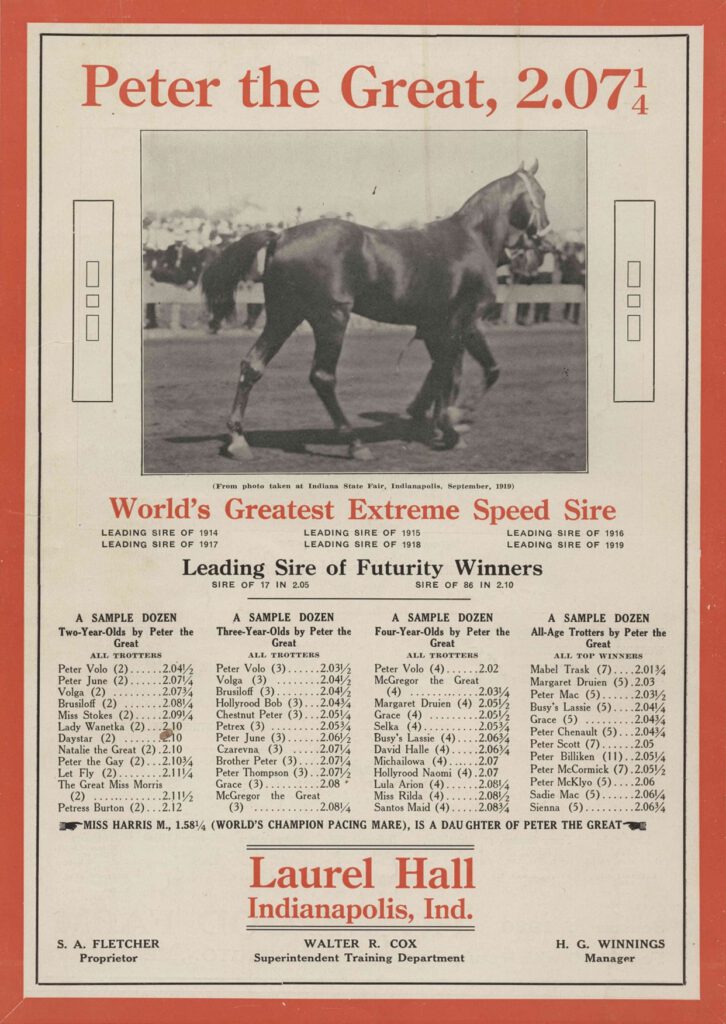
Peter the Great soon proved himself as the premier stallion, alongside Axworthy and his son Guy Axworthy. The colt made Stokes, who eventually bought out Duryea from the Patchen Wilkes Farm, plenty of money as was an extremely sought-after stallion.
Stokes would made even more money on Peter the Great when he was 21. On Feb 11, 1916, a deal was reached where the great stallion was sold for $50,000 to Stoughton Fletcher of Indianapolis, Indiana. He was then taken to Forkland Farm at Lexington, and serviced the mares that were already booked that year. The following year Peter the Great was moved to Laurel Hall Farm at Indianapolis where he stood for the 1918 through 1923 season. It was here that Peter the Great died on March 25, 1923.
Like Dan Patch, the great family founder lay in an unmarked grave for many years. After several attempts a headstone was finally erected in the mid-30s. The American Legion had taken over the place and set a large concrete marker near the grave. At Laurel Hall Farm, Peter the Great had been lovingly taken care of by Jake Councelman, and the aging colt took to his caretaker. When the latter died he was, per his last wishes, cremated and the ashes scattered over the grave of Peter the Great.
An immense legacy
Peter the Great was inducted into the Harness Hall of Fame at Goshen in 1953. In the time before the Hambletonian, the big race to win was the Kentucky Futurity. Peter the Great proved his excellent by siring six winners – Sadie Mac in 1903, Grace/Grace Shaw in 1910, Peter Thompson in 1911, Peter Volo in 1914, Volga E in 1916 and Ethelinda in 1923 – as well as being the damsire of another six winners – Mc McElwyn, Aileen Guy, Iosola’s Worthy, Spencer and McLin Hanover. The latter three are also Hambletonian-winners, and with Greyhound and Lord Jim that makes five Hambletonian-winners with Peter the Great as their damsire. Peter the Great further sired stars such as Peter Scott, Mabel Track, Peter the Brewer, The Laurel Hall and The Senator. To give a full account of Peter the Great at stud would be a massively long article by itself as the great stallion produced numerous good trotters. The trotter who Kalamazoo is certainly one of the most legendary stallions throughout history.
Peter the Great
Bay colt born in Kalamazoo, MI in 1895. Died in Indianapolis, IN on Mar 25, 1923.
Pilot Medium – Santos (Grand Sentinel)
7 starts: 4-2-1 – 4,2:07 1/4 (1.19,1) – $16,862
Breeder: Daniel D Streeter
Owners: Daniel D Streeter – J Malcolm Forbes – Peter Duryea & WED Stokes – WED Stokes – Stoughton Fletcher
Trainers: Peter Johnstone and Henry Titer
Drivers: Peter Johnstone and Henry Titer
Groom: –

